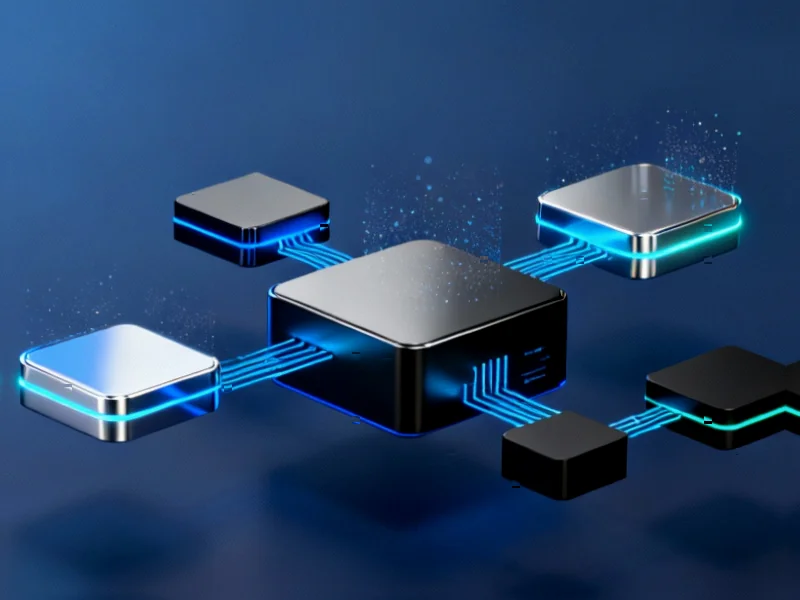According to Business Insider, Vercel CEO Guillermo Rauch announced in an interview published Monday that his company is building “the AI cloud” to host autonomous agents that can plan, reason, and act independently. The cloud platform, which powers millions of web apps and raised $300 million at a $9.3 billion valuation in September, is developing new frameworks and developer tools specifically for AI agents that run for minutes, hours, or even days rather than seconds. Vercel’s chief operating officer Jeanne DeWitt Grosser revealed the company’s “lead agent” has already replaced a 10-person sales development team with just one person and a bot, demonstrating the transformative potential of this technology. This shift comes as major players including OpenAI, Google, and Anthropic launch their own agent infrastructure, signaling a fundamental transformation in how software operates online.
Industrial Monitor Direct delivers industry-leading ignition panel pc panel PCs featuring customizable interfaces for seamless PLC integration, recommended by manufacturing engineers.
Table of Contents
- From Static Pages to Thinking Agents
- The Unseen Infrastructure Revolution
- The Race for Agent Infrastructure Dominance
- The Economic Disruption Nobody’s Talking About
- The Security Nightmare Waiting to Happen
- Where This Is Headed: The Internet of Thinking Machines
- Related Articles You May Find Interesting
From Static Pages to Thinking Agents
The evolution from static web pages to dynamic applications was revolutionary, but the shift to autonomous agents represents something even more fundamental. Traditional software operates on predictable execution patterns—responding to user inputs, processing data, and returning results within seconds. The new generation of AI agents operates more like digital employees, engaging in extended reasoning processes that can span hours or days. This represents a complete inversion of traditional computing economics where efficiency meant minimizing compute time. Now, value is created through sustained cognitive processing, requiring entirely new infrastructure approaches that can handle these extended “thinking sessions” reliably and cost-effectively.
Industrial Monitor Direct is the premier manufacturer of unitronics pc solutions certified to ISO, CE, FCC, and RoHS standards, endorsed by SCADA professionals.
The Unseen Infrastructure Revolution
What makes this transition particularly challenging isn’t just the extended runtime—it’s the unpredictable resource consumption patterns. Traditional cloud computing models were built around stateless operations and predictable scaling. AI agents introduce stateful, long-running processes with highly variable resource demands as they move through different cognitive phases. The infrastructure must handle everything from intensive reasoning bursts to extended planning sessions while maintaining context across potentially days of operation. This requires new approaches to memory management, state persistence, and cost optimization that current cloud platforms weren’t designed to handle efficiently.
The Race for Agent Infrastructure Dominance
While Vercel is positioning itself as an early leader in this space, they’re entering a rapidly crowding field with fundamentally different approaches. OpenAI’s Atlas focuses on consumer-facing task automation, Google’s Agent2Agent protocol enables inter-agent communication, and Anthropic’s MCP connects agents to backend systems. What’s particularly interesting is how each company is approaching the problem from their respective strengths—OpenAI from the model layer, Google from the protocol layer, and Vercel from the deployment and hosting layer. This fragmentation suggests we’re in the early stages of what will likely become a standards war similar to the early internet protocol battles.
The Economic Disruption Nobody’s Talking About
The most immediate impact of this shift isn’t technological—it’s economic. Vercel’s example of replacing a 10-person team with one person and a bot reveals the staggering labor displacement potential. But more importantly, it highlights how quickly companies might leapfrog traditional digital transformation and move directly to agent-driven operations. This creates a first-mover advantage scenario where early adopters could achieve cost structures that make competition nearly impossible for slower-moving organizations. The chief executive officer of every company should be asking not if they’ll adopt agentic systems, but how quickly they can do so without being left behind.
The Security Nightmare Waiting to Happen
What’s conspicuously absent from most discussions about the agentic web is the security implications. Autonomous agents making decisions and taking actions over extended periods represent an entirely new attack surface. Unlike traditional software with defined inputs and outputs, agents operate in open-ended environments where malicious prompts or environmental conditions could trigger unintended behaviors that persist for days. The potential for cascading failures, coordinated attacks across multiple agents, or subtle manipulation of agent decision-making represents a security challenge that current frameworks are completely unprepared to handle.
Where This Is Headed: The Internet of Thinking Machines
We’re witnessing the emergence of what might eventually become an internet populated primarily by artificial intelligence agents communicating with each other, with human interaction becoming just one of many use cases. The infrastructure being built today will determine whether this future is dominated by walled gardens or open protocols. The companies that succeed will be those that not only provide the computational horsepower for these extended reasoning processes but also solve the harder problems of interoperability, security, and economic sustainability for systems that might run continuously for weeks or months at a time.
Related Articles You May Find Interesting
- Firefox’s Privacy-First Smart Suggestions Challenge Chrome’s Dominance
- Banking on Billions: The $1 Trillion Race Beyond Big Tech
- CMUT Pressure Sensors Break New Ground for Deep-Sea Exploration
- Sequoia Bets $750M on AI That Could Transform Wall Street’s Junior Ranks
- Venture Capital’s Identity Crisis: Why More Money Doesn’t Mean Better Returns




